Omahans need places to play, relax and enjoy the outdoors. For more than sixty years, the Carter Lake Club was one of those places. One the longest-lasting social clubs in Omaha history, there are still remnants of the club in the City of Carter Lake today. This is a history of the place.
Grandiose Roots
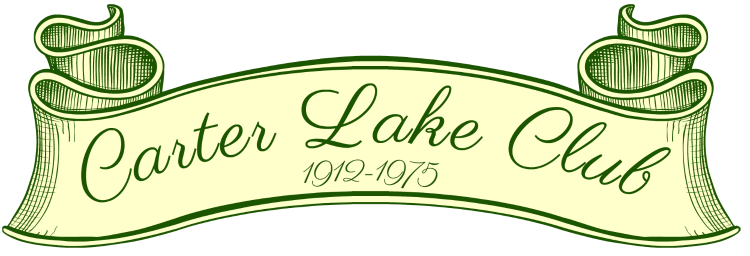
Early in it’s history, the land where the city of Carter Lake sits was debated over between the states of Nebraska and Iowa. Before the great flood of 1877, the land sat on the east side of the Missouri River, which was the natural boundary for the states. However, after the grand flood, the land that today’s city of Carter Lake sits on was on the west side of the river. A series of court cases resolved that the land belongs to Iowa. However, between the beginning and end of those cases, it was called East Omaha and a lot of people thought they lived in Nebraska.
Before any of that was settled, in 1889 the Courtland Beach Amusement Company opened up shop at the south shore of Cut-Off Lake. They built a switchback railroad (now called a rollercoaster), a merry-go-round and a massive pavilion, launching summers of fun and good times. By the mid-1890s though, they ran into rough financial times, so Count John A. Creighton bought the park.

After closing down for a summer in 1906, a new group of investors took over the park and made it into the Omaha Rod and Gun Club. The rollercoaster and most amusement rides were gone, but the club was still popular. In 1912, another organization bought the park, 70 acres of land and the clubhouse and other buildings for $50,000, and called their place the Carter Lake Club.
Welcome to the Club!
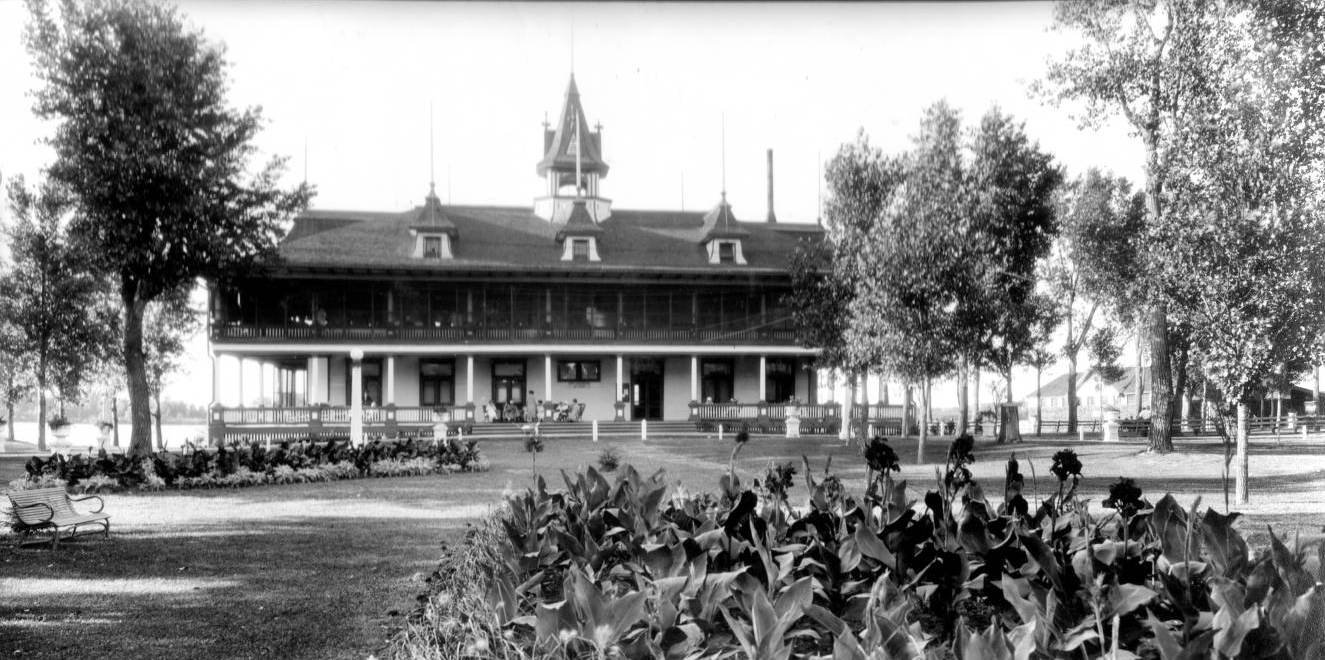
Located at 1410 Avenue Q, the new Carter Lake Club featured the old clubhouse and a new one, as well as the pavilion, an covered outdoor skating rink, parking garages, a separate dancing pavilion, and a sewer system. All of the buildings at the club were painted white with a dark green trim. A grand, wide 2-mile long boulevard led from the Locust Street viaduct to the club, and it was covered in macadam for a smooth driving experience. That first year, trees and flowers lined the boulevard and sidewalks with curbs were built, too. Sewer pipes and indoor plumbing were features of the cottages there.
There were two clubhouses, one for women and one for men, with lockers on the boardwalks along the water. Just before the Carter Lake Club was established, the Omaha Rod and Gun Club built a 170-foot-long seawall along the shore. A new pier was built that went 180 feet into the lake, along with an extravagant new bowling alley. With 14 lanes, it was the largest in Omaha when it was built in 1924, and featured two balconies for observers.
By 1916, the Carter Lake Club had 700 members, with more than 100 permanent houses for 400 people living there year-around. According to a newspaper feature, the homes cost between $2,000 and $15,000 to build, and their value steadily increased. In 1923, a cafe was opened up at the club and run by Howard Hauck, who’d run cafes at the Conant and Paxton Hotels in downtown Omaha. There was also a popular soda fountain in the bowling alley, with more than three dozen tables. A movie theater at the club sat 450 people, and had two shows every evening.
The club offered dancing and swimming lessons for adults and children. The dance hall was large enough to hold 700 couples dancing, with 500 spectators watching. The beach had top notch lifeguards, and claimed nobody ever drowned there.
A small baseball baseball stadium graced the grounds and proved a mecca. Claiming a Class “A” team, the Carter Lake Club baseball team placed second in the league consistently, and often gunned for first. They played in Omaha’s Metropolitan League, which included teams like Russel Sports, Saunders Drive-Its, Edholm Shermans, Murphy-Did-Its, Burlington and the Omaha Prints. Over the years, they also battled the 13th Street Merchants, Brandeis, the Eighteenth Infantry Marines and Mainelli Construction. Johnny Rosenblatt played for Carter Lake occasionally.
When the stock market crashed in 1929, hard times hit the club. However, in 1930 the club was renovated, tennis courts were refurbished, “tons of fine sand was dumped on the beach,” and the summer agenda that year was packed. In addition to the regular boating, bowling, swimming, baseball, fishing and dancing, golf was introduced, croquet was popular, and archery took hold. Sunset diners called club members to the pavilion, and the club went from 500 to 1,000 members. Wealthy members were encouraged to build new cottages at the club, and the growth sustained.
Did the Club Survive?

A legal battle broke out in 1932. After the last court trial between Nebraska and Iowa over the land that became the City of Carter Lake, Iowa, the Nebraska-registered Omaha Rod and Gun Club was given 20 years to vacate ownership of their land and re-organize as an Iowa corporation. When that time passed in 1932, it turned out the people who’d built houses at the Carter Lake Club didn’t actually own the land they were built on.
Remember the Carter Lake Club was the successor organization of the Omaha Rod and Gun Club, and since they hadn’t re-registered in Iowa, they had to take action. Initially offering each of the homeowners leases for their lands, many balked. They refused to pay for something they didn’t own, but refused to move. After two years of court fights and infighting and haggling and threats, in 1932 the club acquiesced and gave the homeowners title to their land.
The Carter Lake Club survived.
Outdoor Fun in the Sun
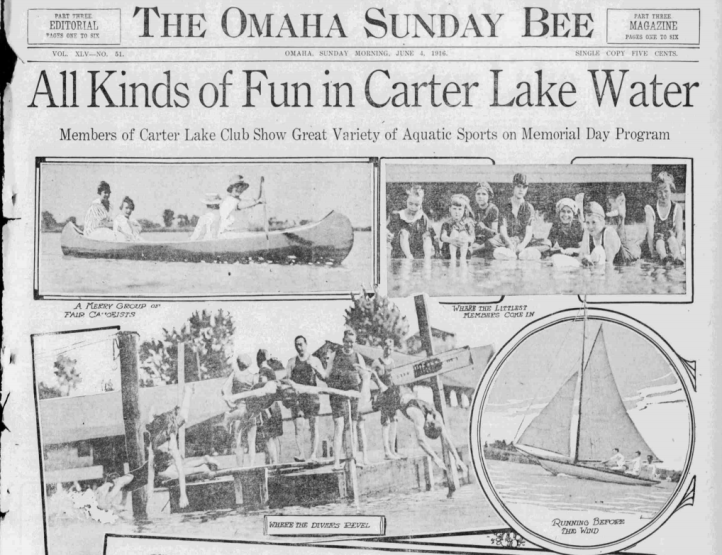
The Carter Lake Club continued existing. Located at present-day 213 Carter Lake Club, the former pavilion was referred to as a ballroom, and people loved it.
In the 1950s, it was included in a massive feature in the Omaha World-Herald focused on Carter Lake’s boating community. By that time, the Carter Lake Pleasure Pier and Kiddie Land were coming to fruition, and the popularity of the nearby Omaha Municipal Beach was waning. But the newspaper estimated there were 200 boats at the lake, with 150 being used on any given summer weekend. It said the lake had 20 boat slips for members of the club, as well as a boathouse. With motorboat racing confined to the west arm of the lake by this point, the middle was home to all the canoes, rowboats, sailboats and motorboats. The east arm was for fishing.
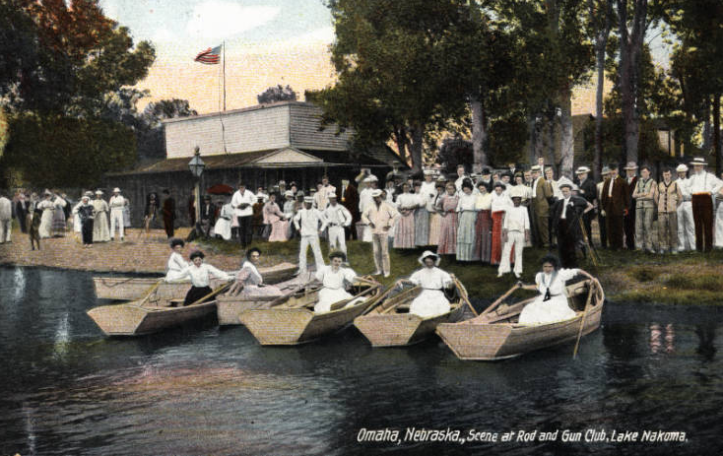
In 1955, a newspaper article bragged about how comfortable Carter Lake was. “The weather is cooler here in the summer. I’m only a block from the lake and enjoy the summer sports,” said one resident. A 15-year-old was quoted saying, “We have lots of fun down by the lake. I’d rather live here than in Omaha. Its quieter.”
In 1970, the Carter Lake Club hosted the Iowa State Water Ski Championships, and took the team honors. This went on for a long time, with a 1981 article highlighting the Carter Lake Club’s water skiing program, which aimed to teach kids and adults to like swimming, enjoy water skiing and appreciate the lake more. In that article, a member of the club said, “Carter Lake Club members include several factory workers, housewives, railroad engineers and employees of the utility districts.”
Party Central
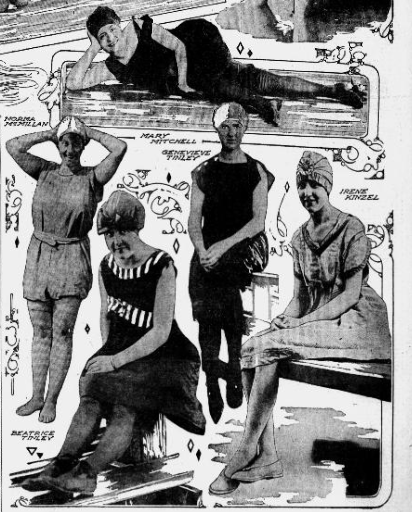
Over the years, enthusiasm for the community club lifestyle waned and came to an end. In 1938, a local businessman named Joseph Malec, Sr. bought the ballroom. Apparently, the Carter Lake Club lost it against a tax lien. Malec immediately rented it out for bingo, and drew up plans for a 9-hole golf course. In 1951 it was opened to private groups and organizations.
Malec renovated the building extensively in the 1950s. Among other things, he resurfaced the exterior of the building and painted the interior. He also removed the Victorian-era features, many of which were in poor condition and couldn’t be kept, like window shutters, cupolas with flagpoles, and other flourishes. The porches were screened in, and the entryway was made plain.
Between the 60s and 70s, bingo nights were held four nights a week, with dances and concerts happening almost every weekend. Tuesday was the single night every week the club wasn’t open. This giant building, which held up to 1,000 people, became a popular concert venue. Every ticket sold for almost every show, and people could bring their own beer to rock out and have a good time.
Arson and a New Facility
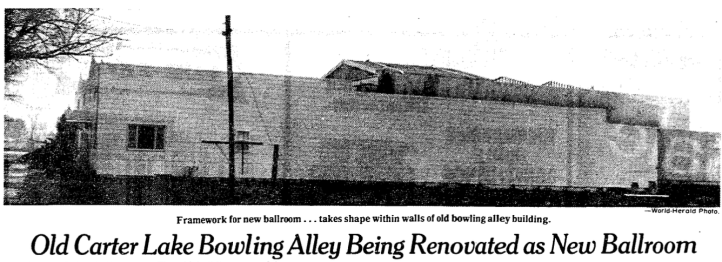
In December 1975, an arson’s fire destroyed the Carter Lake Club, which was also called the Carter Lake Ballroom by this point. The caretaker wasn’t present when the fire began, and it happened on the only night of the week the club wasn’t used. Four fire departments responded with 11 trucks, only to experience a lack of water to fight the fire. There were several small explosions within the structure during the night while it burned. An investigation showed the ballroom was forcibly entered.
The Malec family had spent more than $150,000 in renovations the previous year, and it was all gone. Their other endeavor, a little amusement center called Peony Park, was doing well, but the Carter Lake Club bit it. After the fire, talked about rebuilding it, but that didn’t happen. They also talked about renovating the old bowling alley, but its gone today, too. This fire was one of several arsons that happened throughout Carter Lake in the early 1970s.

In 1976, the Malecs renovated the former bowling alley at the Carter Lake Club and call it “The Warehouse.” A second arson happened six months after the first, during the renovation of the bowling alley. Apparently, Malec’s successful Tuesday night dances at Peony Park encouraged him to invest in the new ballroom that replaced the old Carter Lake Club. Located across the street from the old pavilion, the new club held 1,100 people and hosted bingo, dances and concerts, as well as private events. It was also called the Carter Lake Ballroom, and was often referred synonymously with its predecessor, even though they were distinctly different buildings with completely different roots. The Warehouse ballroom stayed open through 1991.
In 1992, The Warehouse Ballroom was closed and demolished to make way for a new housing development around a new shoal.
Today, there are streets in the City of Carter Lake called “Carter Lake Club,” and the Carter Lake Improvement Club building is nearby the former site of the club. However, all remnants of the 1896 building that once stood there, as well as the steamboat docks, bowling alley, movie theater and other highlights of the Carter Lake Club are all gone. There’s no marker or signage of any kind left from this once-grand Carter Lake institution.
Do you have memories of the Carter Lake Club? Please share them in the comments section!
Carter Lake Club Timeline
- 1877—Carter Lake is formed as an oxbow lake when a massive flood moves the Missouri River channel to the east. Nebraska claims the land of East Omaha, including all of the present-day City of Carter Lake, is part of Nebraska. Iowa disagrees.
- 1889—Frank D. Kent opens the Courtland Beach Amusement Park near present-day North 9th and Ave Q in the present-day City of Carter Lake, Iowa.
- 1892—The US Supreme Court says the land present-day Carter Lake sits on is actually in Iowa.
- 1895—The pavilion, steamboat landing, rollercoaster, merry-go-round, and other items are added to Courtland Beach.
- 1896—Count John A. Creighton begins 10 years of fiscal support to keep the park open at a loss.
- 1906—The Omaha Rod and Gun Club starts operating Courtland Beach.
- 1912—The Omaha Rod and Gun Club is renamed the Carter Lake Club.
- 1938—The Carter Lake Club facilities are sold to Joseph Malec, who also owned Peony Park.
- 1951—Malec renovates the pavilion and makes it into a rental space and bingo hall.
- 1975—An arson destroys the Carter Lake Club, aka the Carter Lake Ballroom.
- 1976—The Warehouse, a new rental space and bingo hall, is opened by Malec in the former Carter Lake Club bowling alley and movie theater at North 15th and Ave Q.
- 1992—The Warehouse is closed and demolished to make way for a new housing development around a new shoal.
You Might Like…
MY ARTICLES ABOUT THE HISTORY OF EAST OMAHA
SEE ALSO: East Omaha History Tour
AREAS: Town of East Omaha | Carter Lake | Winspear Triangle | North Omaha Bottoms | Sherman | Sulphur Springs | Edgewood Park | Bungalow City | Squatter’s Row | Lakewood Gardens
BUSINESSES: East Omaha Truck Farms | Carter White Lead Company | Nite Hawkes Cafe | Railroads
CARTER LAKE, IOWA: Courtland Beach | Omaha Rod and Gun Club | Carter Lake Club | Sand Point Beach and Lakeview Amusement Park | Omaha Auto Speedway
CARTER LAKE PARK: Municipal Beach | Bungalow City | Pleasure Pier and Kiddieland
PEOPLE: Selina Carter Cornish | Levi Carter | Granny Weatherford
TRANSPORTATION: Ames Avenue Bridge | Eppley Airfield | 16th and Locust Streets | JJ Pershing Drive | North 16th Street | Pulitzer Airfield | Locust Street Viaduct
SCHOOLS: Beechwood School | Pershing School | Sherman School | St. Therese Catholic School
OTHER: The Burning Lady | CCC Camp | St. Therese Catholic Church | 1898 Trans-Mississippi Exposition
Listen to our podcast “A History of East Omaha” online now!
Elsewhere Online
BONUS PICS!





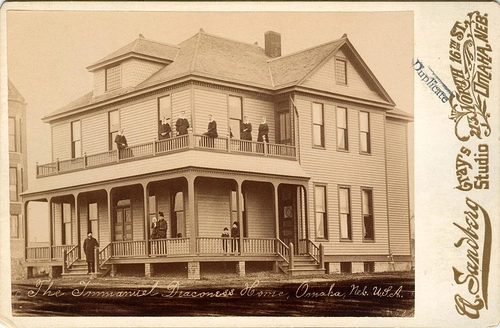

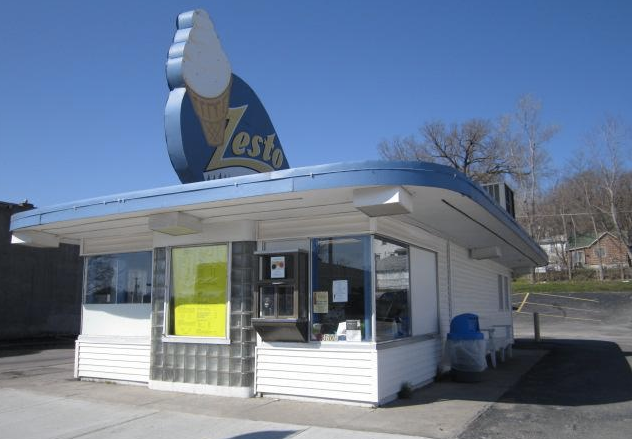
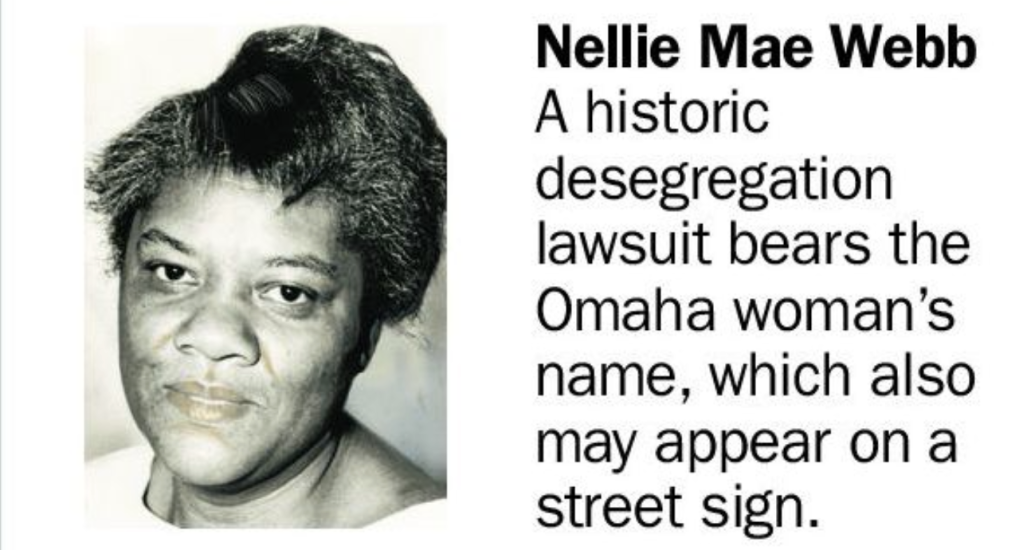
Leave a comment